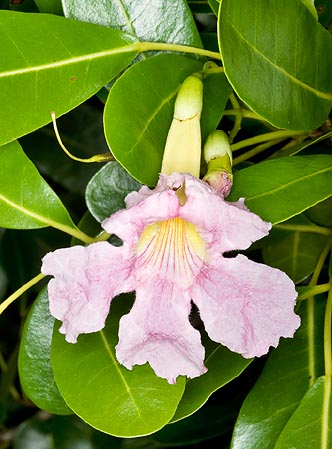Family : Bignoniaceae

Text © Pietro Puccio

English translation by Mario Beltramini

10-15 m tree for the Tropics © Giuseppe Mazza
The name of the genus is the name in Tupian language given in Brazil by the natives to some plants belonging to the same genus, and is the combination of the names “ant” and “wood”, with reference to the mutual relation between ants (protection from herbivores) and tree (hospitality); the Latin name of the species “pallida” = pale, refers to the colour of its flowers.
Common names: “white cedar”, “whitewood” (English); “calice du pape”, “poirier blanc”, “poirier-pays” (French); “roble de Florida”, “roble merrill”, “cáliz de papel” (Spanish); “ipê rosa (Portuguese).
Semi-deciduous tree, about 10-15 metres tall, with a grey-brown bark, cracked in adult specimen, it shows simple, or 3-leaflets, leaves, of elliptic shape, about 16×6 cm, of a glossy dark green colour.
Terminal or lateral inflorescences with funnel-shaped flowers, long about 8 cm, of white or pale pink colour, with throat suffused with yellow.
The fruits are 12-18 cm long capsules with a diameter of about 1 cm, containing many winged seeds. It easily reproduces by seed.
Tree rather spread in tropical and subtropical countries, in particular in those with clear seasonal climate, due to its resistance to long drought periods; quite appreciated for its blooming and the ornamental foliage, is utilized also for boulevards landscaping.
Heliophile plant, is not particular in soil, provided well drained; it is sensitive to low temperatures, as it does not bear temperatures close to 0°C, but for a very short time.
Synonyms: Bignonia pallida Lindl. (1826); Bignonia cranalis Krause (1914); Tabebuia dominicensis Urb. (1924); Tabebuia heterophylla subsp. dominicensis (Urb.) Stehlé (1946); Tabebuia heterophylla subsp. pallida (Lindl.) Stehlé (1946); Tabebuia pallida subsp. dominicensis (Urb.) Stehlé (1945).
